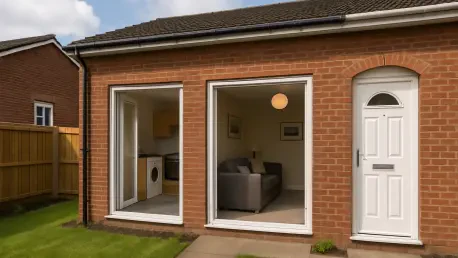The UK Government’s recent initiative to revise the Decent Homes Standard (DHS) and extend its reach into the private rented sector through the Renters’ Rights Bill has sparked a robust conversation within the housing industry, aiming to ensure that tenants across all sectors live in safe, warm, and well-maintained homes while addressing long-standing concerns about housing quality. Propertymark, a prominent organization representing property agents throughout England, has gathered extensive feedback from its members through surveys and roundtable discussions to assess the implications of these updates. Their response encapsulates a blend of support for improved tenant conditions and apprehension over the practical and financial challenges that may arise for landlords and agents. Key areas of focus include definitions of disrepair, safety enhancements, damp and mold prevention, and thermal comfort standards. This article delves into the nuanced perspectives provided by Propertymark, highlighting the balance between elevating housing standards and ensuring feasible implementation.
Navigating the Extension to Private Rentals
The proposal to apply the Decent Homes Standard to the private rented sector marks a significant shift in housing policy, aiming to align conditions with those in social housing. Propertymark recognizes that many properties under their members’ management already adhere to existing benchmarks, reflecting a commitment to quality. However, the introduction of new obligations around safety protocols, damp prevention, and clearer repair thresholds raises concerns about the added responsibilities. Property agents express cautious support for enhancing tenant living environments but underscore the potential financial strain and logistical complexities of compliance. There’s a palpable worry that without adequate government backing or resources, these changes could overburden landlords, particularly those managing smaller portfolios or older properties. The feedback emphasizes the need for a supportive framework to ease this transition, ensuring that the goal of safer homes doesn’t inadvertently penalize those striving to meet standards.
Beyond the immediate concerns of cost and logistics, Propertymark’s feedback highlights a broader desire for clarity in how these new rules will be rolled out. Agents stress that the extension must come with detailed guidance to prevent misinterpretation or inconsistent application across different regions. The diversity of properties in the private rented sector—ranging from modern apartments to historic homes—adds another layer of complexity, as a one-size-fits-all approach may not be practical. There’s also a call for mechanisms to address disputes or challenges that arise during implementation, ensuring fairness for both tenants and property managers. The consensus points to a balanced perspective: while the intent behind extending the DHS is commendable, its success hinges on thoughtful planning and robust support systems to address the unique challenges of private rentals. Without such measures, there’s a risk that the policy could create more hurdles than solutions for an already stretched sector.
Prioritizing Condition Over Rigid Timelines
A central theme in Propertymark’s response is the push to assess property components based on their actual condition rather than arbitrary age-based replacement mandates. For instance, the notion of replacing kitchens or bathrooms after a set number of years—such as 20—is met with resistance, as it overlooks the functionality and safety of these elements. Agents argue that focusing on the state of repair is not only more cost-effective but also respects the character of older properties, which tenants often find appealing. This approach avoids unnecessary expenditures while ensuring that critical safety issues are addressed promptly. An exception is acknowledged for items like boilers, where manufacturer-recommended lifespans provide a logical basis for replacement to prevent hazards. This nuanced stance reflects a desire to maintain high standards without imposing undue financial pressures on property owners.
Further exploration of this feedback reveals a deeper concern about preserving tenant satisfaction alongside safety. Propertymark members note that many renters value the unique features of older homes, such as vintage fixtures, which could be lost under strict replacement rules. A condition-based evaluation allows for flexibility, ensuring that only components posing genuine risks are prioritized for updates. This method also aligns with sustainable practices by reducing waste from unnecessary renovations. However, the challenge lies in defining clear criteria for what constitutes a safety or functionality concern, as vague standards could lead to inconsistent enforcement. Agents advocate for collaborative efforts with industry experts to establish these benchmarks, ensuring they are both practical and protective. This focus on condition over arbitrary timelines underscores a pragmatic approach to housing standards, aiming to balance quality with economic realities for all parties involved.
Enhancing Safety Without Overreach
Safety remains a cornerstone of Propertymark’s feedback, with strong support for measures that address immediate risks to tenants. One notable suggestion is to lower the threshold for identifying failing building components, enabling earlier repairs to prevent deterioration. Additionally, there’s a push to include specific elements like handrails, balustrades, and stair treads in the list of critical components, given the high incidence of falls in rental properties. These additions are seen as practical steps to enhance tenant well-being without imposing excessive burdens. Yet, there’s a caveat against overly stringent rules for older buildings, where natural wear and tear is inevitable. Agents argue that minor cosmetic issues, such as cracked tiles, should not result in penalties if they don’t compromise safety or comfort, highlighting the need for a discerning approach to enforcement.
Delving deeper into safety concerns, Propertymark emphasizes the importance of tailoring standards to the unique challenges of different property types. Older structures often require more frequent maintenance, but this shouldn’t automatically equate to non-compliance under the DHS. The feedback suggests that enforcement should prioritize genuine hazards over superficial flaws, ensuring that landlords aren’t unfairly targeted for issues beyond their control. There’s also a call for educational resources to help property managers identify and address safety risks proactively, fostering a culture of prevention rather than reaction. This balanced perspective seeks to elevate living conditions while acknowledging the practical limitations faced by those managing diverse rental portfolios. By focusing on meaningful safety enhancements, the feedback aims to create a framework that protects tenants without alienating property providers through unrealistic expectations.
Addressing Damp and Mold Challenges
The issue of damp and mold emerges as a critical focus in Propertymark’s response, with a clear demand for nuanced guidelines to distinguish between structural and tenant-induced causes. Agents caution against overly broad criteria that could hold landlords accountable for minor issues or those resulting from tenant behavior, such as inadequate ventilation or drying clothes indoors. Clear distinctions are needed to ensure fairness, as structural defects like leaks fall under landlord responsibility, while lifestyle factors often require tenant cooperation. The feedback calls for detailed guidance to clarify these boundaries, preventing disputes and fostering accountability on both sides. Consistency in how these rules are applied across regions is also a priority, with a push for standardized training for enforcement officers to avoid discrepancies in interpretation.
Expanding on this concern, Propertymark highlights the complexity of managing damp and mold in diverse property settings. Older buildings, for instance, are more prone to moisture issues due to their construction, yet retrofitting solutions can be prohibitively expensive. Agents stress that without clear directives, there’s a risk of a patchwork enforcement system where outcomes depend on local interpretations rather than national standards. There’s also a suggestion for public awareness campaigns to educate tenants on preventing mold through simple actions like opening windows or using dehumidifiers. This dual approach—combining precise guidelines for landlords and educational outreach for renters—aims to tackle the issue holistically. By addressing both root causes and contributing behaviors, the feedback seeks to create a fair system that improves living conditions without placing undue blame or burden on any single party.
Aligning Thermal Comfort with Energy Efficiency
Thermal comfort stands out as another pivotal area in the proposed updates, with Propertymark advocating for an integrated approach that aligns with existing energy efficiency regulations like the Minimum Energy Efficiency Standards (MEES). The connection between heating, insulation, and ventilation is seen as essential to maintaining healthy homes, and harmonizing these standards could prevent overlapping or contradictory requirements for landlords. Such alignment would not only enhance tenant well-being by ensuring warmer, drier living spaces but also streamline compliance efforts for property managers. Additionally, there’s a call for financial assistance to support landlords who have already invested in energy upgrades but now face new DHS mandates, ensuring they aren’t doubly penalized for their efforts to improve properties.
Further analysis of this feedback reveals a broader concern about the cumulative impact of multiple regulatory frameworks on the rental sector. Propertymark notes that without coordination between DHS and MEES, landlords could face confusion or redundant costs, potentially discouraging investment in property improvements. The suggestion of financial aid reflects a pragmatic recognition that many property owners operate on tight margins, especially in the private rented sector. There’s also an emphasis on tenant benefits, as better thermal comfort directly correlates with reduced health risks and improved quality of life. The feedback urges policymakers to consider pilot programs or phased rollouts to test how these integrated standards work in practice, minimizing disruptions. This comprehensive approach seeks to create a cohesive system that prioritizes tenant health while supporting landlords in meeting evolving expectations.
Reevaluating Facility Mandates for Practicality
Propertymark expresses significant reservations about the proposal to mandate specific facilities—such as adequate kitchen space, noise insulation, or common areas in flats—due to the vast diversity of rental properties. Many factors, like external noise in urban areas, lie beyond a landlord’s control, making compliance challenging or impossible in certain contexts. Retrofitting older buildings to meet structural requirements is often deemed financially unfeasible, risking the classification of otherwise decent homes as non-compliant. Instead, the feedback recommends focusing on core safety and functionality aspects that directly impact tenant experience, arguing that rigid facility mandates could create unfair outcomes for property managers and owners who are otherwise maintaining quality homes.
Building on this critique, the response underscores the need for flexibility in how standards are applied to different property types. For instance, shared accommodations or historic buildings often face unique constraints that modern constructions do not, yet they can still provide safe and comfortable living spaces. Propertymark suggests that assessments should prioritize tenant feedback on livability over strict checklists that may not account for practical realities. There’s also a concern that overly prescriptive rules could deter investment in the private rented sector, reducing housing availability at a time when demand is high. The emphasis remains on ensuring that standards enhance tenant well-being without imposing unrealistic expectations that could backfire. This perspective calls for a more tailored approach, recognizing the varied landscape of rental properties and the limits of what landlords can reasonably achieve in certain environments.
Enforcement Capacity and Consistency Issues
The interaction between the updated DHS and existing local authority licensing schemes raises substantial concerns within Propertymark’s feedback, particularly regarding enforcement capacity. With overlapping regulations from the Renters’ Rights Bill and energy efficiency mandates, there’s a fear that enforcement teams will be overstretched, leading to delays or inconsistent application. The response advocates for dedicated funding to bolster local authority resources, ensuring they can handle the increased workload. National guidelines are also deemed essential to prevent a fragmented system where compliance outcomes vary by region, creating uncertainty for landlords and agents. An initial focus on education and advisory support, rather than immediate penalties, is seen as a constructive way to encourage adherence to new standards.
Looking deeper into enforcement challenges, Propertymark highlights the risk of unintended consequences if implementation isn’t carefully managed. Without adequate staffing or training, local authorities may struggle to interpret and apply the updated DHS uniformly, potentially leading to disputes or non-compliance through misunderstanding rather than intent. The suggestion of ring-fenced funding reflects a recognition that effective enforcement requires investment, not just policy changes. Additionally, there’s a push for technical assistance programs to help property managers navigate the new rules, fostering a collaborative rather than punitive environment. This feedback aims to build a system where enforcement supports the overarching goal of better housing while addressing the practical limitations faced by both authorities and the rental sector. A well-resourced, consistent approach is viewed as critical to the success of these updates.
Reflecting on a Balanced Path Forward
Looking back, Propertymark’s input on the revisions to the Decent Homes Standard offered a measured critique that championed tenant safety while advocating for practical and equitable solutions. Their response underscored the necessity of condition-based assessments, precise guidelines, and a supportive enforcement model that valued education over hasty sanctions. Key challenges, such as the financial strain of retrofitting diverse properties and the shared responsibility for issues like damp and mold, were thoroughly examined, as was the capacity of local authorities to manage new regulations. Moving forward, the insights pointed to actionable steps like securing funding for enforcement, developing clear national standards, and providing financial relief for landlords facing overlapping mandates. Collaboration between government, industry professionals, and local bodies emerged as vital to refining these updates, ensuring they uplifted housing quality without creating unintended burdens for the rental sector.









